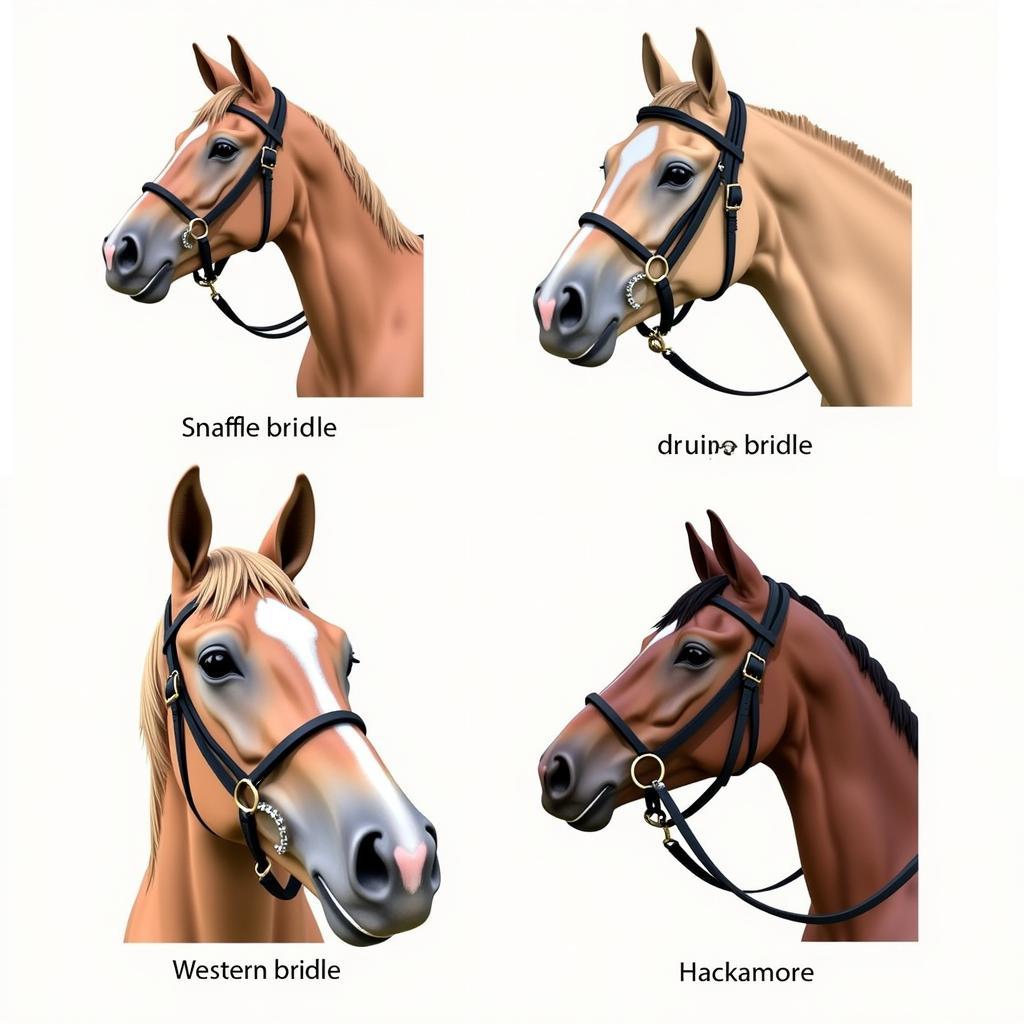A horse bridle is an essential piece of equipment for any equestrian, acting as the interface between rider and horse. It’s much more than just straps and buckles; it’s a communication system that allows for control and guidance. This article delves into the intricacies of the bridle of a horse, exploring its components, various types, fitting techniques, and more.
Deconstructing the Horse Bridle: Key Components
A standard horse bridle comprises several crucial parts, each serving a specific purpose:
- Crownpiece: This strap sits behind the horse’s ears, running over the head and connecting other parts of the bridle.
- Cheekpieces: Two straps running down the sides of the horse’s face, connecting the crownpiece to the bit.
- Browband: Positioned across the horse’s forehead, preventing the bridle from slipping back.
- Throatlatch: Fastens under the horse’s throat, keeping the bridle securely in place.
- Noseband: Encircles the horse’s nose and can vary in style and purpose, from preventing the horse from opening its mouth too wide to providing an attachment point for other equipment.
- Bit: The metal mouthpiece that sits in the horse’s mouth, acting as the primary communication tool between rider and horse. Reins attach to the bit, allowing the rider to steer and control the horse’s speed.
Types of Horse Bridles: A Diverse Selection
Bridles come in a variety of styles, each designed with specific disciplines and purposes in mind. Some common types include:
- Snaffle Bridle: The most basic and widely used type, suitable for everyday riding and training. It features a single bit and reins.
- Double Bridle: A more advanced bridle used in dressage and other high-level disciplines. It utilizes two bits – a snaffle bit and a curb bit – for greater control and precision.
- Western Bridle: Characterized by a simpler design often lacking a noseband. It’s commonly used in Western riding disciplines.
- Hackamore: A bitless bridle that relies on leverage and pressure points on the horse’s nose and head for control, offering an alternative for horses that have difficulty accepting a bit.
 Different Types of Horse Bridles
Different Types of Horse Bridles
Finding the Perfect Fit: Bridle Fitting for Horses
A properly fitted bridle is essential for the horse’s comfort and performance. Here’s a step-by-step guide:
- Check the Crownpiece: It should lie comfortably behind the horse’s ears without putting pressure on the poll.
- Adjust the Cheekpieces: Ensure the bit rests comfortably in the horse’s mouth, creating two wrinkles at the corners.
- Fit the Browband: It should sit about an inch above the horse’s eye, allowing for two fingers to fit comfortably between the browband and the horse’s forehead.
- Fasten the Throatlatch: Leave enough space to fit a fist loosely between the throatlatch and the horse’s throat.
- Adjust the Noseband: The tightness and positioning depend on the type of noseband used. Consult a professional if unsure about proper noseband adjustment.
Caring for Your Horse’s Bridle
Regular cleaning and maintenance are crucial to keep the bridle in top condition:
- Clean After Every Ride: Wipe down the bridle with a damp cloth to remove sweat, dirt, and grime.
- Condition Regularly: Use leather conditioner to keep the leather supple and prevent cracking.
- Store Properly: Hang the bridle on a bridle rack in a cool, dry place when not in use.
Bridle of Horse: An Essential Partnership
The bridle of a horse is more than just a means of control; it represents a partnership between horse and rider. A properly fitted bridle, combined with sensitive hands and clear communication, allows for a harmonious and enjoyable riding experience. Remember, understanding the different types of bridles, their components, and fitting techniques is crucial for any horse owner or rider.
FAQs About Horse Bridles
Q: How do I know what type of bridle is right for my horse?
A: The best bridle for your horse depends on their training level, discipline, and individual needs. It’s always best to consult with a qualified riding instructor or equine professional for personalized advice.
Q: Can I ride my horse without a bridle?
A: While it’s possible to ride a horse using only a halter and lead rope, it’s generally not recommended for beginners. Riding bitless requires a well-trained horse and a skilled rider who can communicate effectively without relying on a bit.
Q: How often should I replace my horse’s bridle?
A: The lifespan of a bridle depends on its quality, usage, and how well it’s maintained. Inspect the bridle regularly for signs of wear and tear, such as cracked leather or loose stitching. Replace any damaged parts promptly and consider replacing the entire bridle every few years, or sooner if it shows significant wear.
Need Help Finding the Perfect Bridle for Your Horse?
Choosing the right horse equipment can be overwhelming. For personalized advice and a curated selection of high-quality bridles, explore our range of breast straps for horses, horse collar hames, and other essential gear at Justus Horses USA. Contact our team of experts at 0772127271 or [email protected]. We’re here to help you find the perfect fit for your equine partner! Visit our store located at QGM2+WX2, Vị Trung, Vị Thuỷ, Hậu Giang, Việt Nam, to experience our products firsthand. We offer 24/7 customer support to ensure you have the best possible experience.